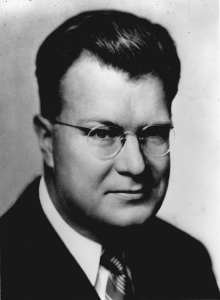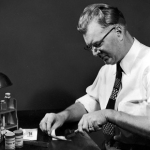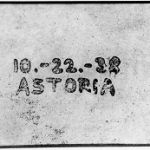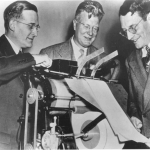
Today is National Inventors’ Day—the perfect time to celebrate our innovators’ dogged determination at finding better solutions for common problems. At Xerox, our legacy of innovation traces back to one man: Chester Carlson, the inventor of xerography. His hard work and dedication sparked an invention that created an entire industry. This propelled the modern Xerox we know today.
There Had to Be a Better Way
As the Great Depression deepened, Carlson was working in the patent department at an electronics firm in New York City that routinely needed copies of documents. Carbon paper or mimeographs were the options of the day, but they required making a special master copy first: error prone, time-consuming and messy.
Carlson felt there had to be a better way.
In 1936, on track to become a patent attorney, Carlson studied law after work at night in the New York Public Library. As he made longhand copies from books that he couldn’t afford to buy, he assuredly felt a burning need for some kind of machine to help. A document copier.
The Spark
 He took a break from the law books now and then to read from the body of scientific research that might help in his quest. In a scientific journal, Carlson found a spark: a theoretical article written by a Hungarian physicist Pál Selényi, about imparting an electrostatic charge to a rotating drum of insulating material. The drum would capture an image that could be transferred to paper dusted with a dry ink powder.
He took a break from the law books now and then to read from the body of scientific research that might help in his quest. In a scientific journal, Carlson found a spark: a theoretical article written by a Hungarian physicist Pál Selényi, about imparting an electrostatic charge to a rotating drum of insulating material. The drum would capture an image that could be transferred to paper dusted with a dry ink powder.
Before a year had passed, Carlson filed his first preliminary patent application based on his many experiments.
The Kitchen Years
In a makeshift kitchen laboratory at the back of a beauty parlor in Astoria, Queens, Carlson discovered the recipe for a workable photoconductor. He made a modest text image on a glass slide, exposed it to bright light, dusted it with powder and… successfully transferred it to paper.

The word’s first xerographic copy was a simple declaration of date and place: ‘10 – 22 – 38 ASTORIA.’
Carlson advanced that initial success incrementally for four more years before being issued a patent for electrophotography in October 1942.
X Marks the Name
The Haloid Company loved the concept – opting to create a new name for the process that is now a part of business lore: ‘xerography’ – from the Greek xeros (‘dry’) and graphḗ (‘writing’). Carlson didn’t like it much, but knew the name wouldn’t matter if they couldn’t bring a machine to the market. He was betting on Haloid to provide the resources to make that happen.
 After another decade of development, the Xerox 914 was born. It was the world’s first fully automatic, plain-paper copier. Three years after its introduction, company revenues almost doubled.
After another decade of development, the Xerox 914 was born. It was the world’s first fully automatic, plain-paper copier. Three years after its introduction, company revenues almost doubled.
The rest is history – a history illuminated by a sliver of light moving across a glass again and again. Xerox not only created a product, it created an industry. With more than 11,000 active U.S. patents and a focus on setting the page free, Xerox is finding new ways to improve the flow of work in the office, be it in digital or paper form. We’re developing new ways to print–not only on paper, but directly onto complex objects. And we’re directly printing electronics for smart labels and packaging that will power the Internet of Everything.
Read more from the National Inventors’ Day Series:
Part I: Xerox Celebrates National Inventors’ Day >
Part II: Michelle Chretien: Making the Un-makeable >
Part III: Guerino Sacripante: Sustainable Ink for Eco-Responsible Printing >
Part IV: Ajay Raghavan: Making Batteries Work Better >
Part V: Gary Starkweather Invented the Laser Printer Over 40 Years Ago >



